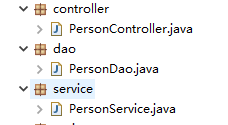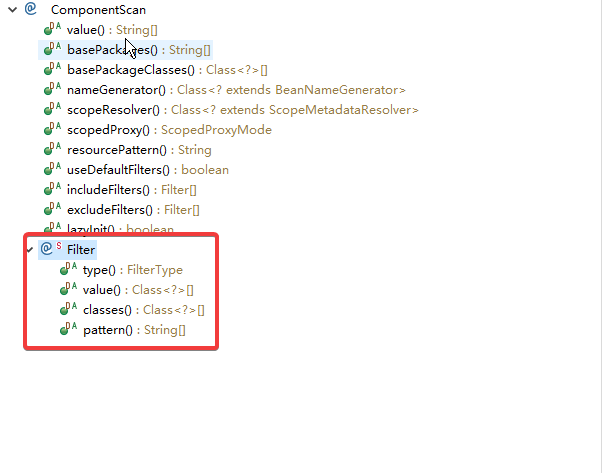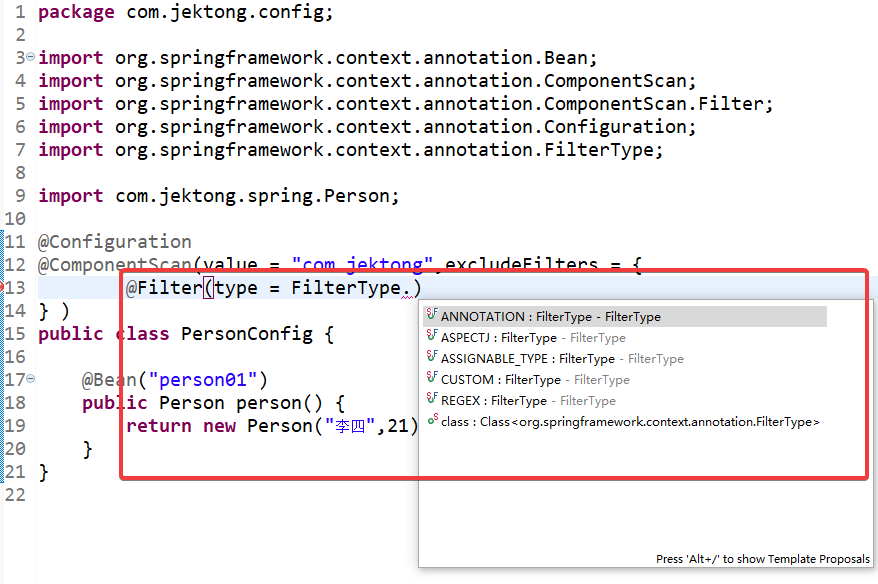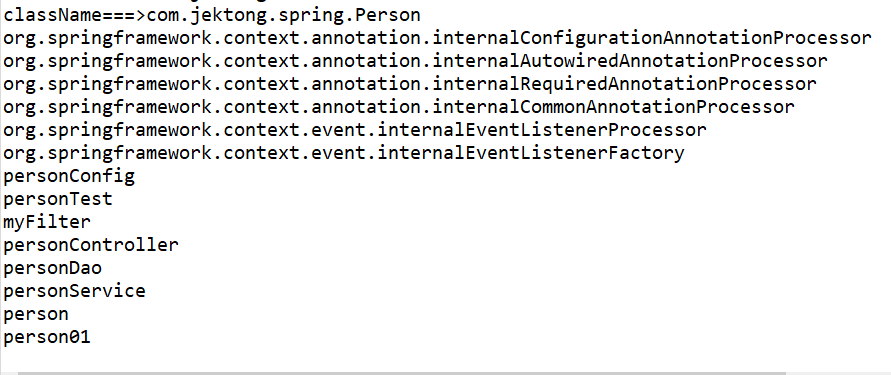Spring之@ComponentScan自动扫描组件怎么使用
这篇文章主要讲解了“Spring之@ComponentScan自动扫描组件怎么使用”,文中的讲解内容简单清晰,易于学习与理解,下面请大家跟着小编的思路慢慢深入,一起来研究和学习“Spring之@ComponentScan自动扫描组件怎么使用”吧!
无注解方式component-scan使用
之前,我们需要扫描工程下一些类上所标注的注解,这些常用注解有:
@Controller,@Service,@Component,@Repository
通过在Spring的配置文件中配置<context:component-scan>扫描对应包下扫描这些注解的方式:
<beans xmlns="http://www.springframework.org/schema/beans"xmlns:xsi="http://www.w3.org/2001/XMLSchema-instance"xmlns:p="http://www.springframework.org/schema/p"xmlns:context="http://www.springframework.org/schema/context"xsi:schemaLocation="http://www.springframework.org/schema/beans http://www.springframework.org/schema/beans/spring-beans.xsd http://www.springframework.org/schema/context http://www.springframework.org/schema/context/spring-context-2.5.xsd"> <!--@Controller,@Service,@Component,@Repository--><context:component-scan base-package="com.jektong.spring"/></beans>注解方式@ComponentScan使用
建三个类,依次将
@Controller,@Repository,@Service,标注这些类:

图1
现在通过使用注解@ComponentScan的方式来扫描所在包下面的这些类:之前定义的PersonConfig修改:
package com.jektong.config;import org.springframework.context.annotation.Bean;import org.springframework.context.annotation.ComponentScan;import org.springframework.context.annotation.Configuration;import com.jektong.spring.Person;@Configuration@ComponentScan("com.jektong")public class PersonConfig {@Bean("person01")public Person person() {return new Person("李四",21);}}测试,看是否扫描到这些注解所标注的类:PersonTest.java
@Testpublic void test02() {ApplicationContext ac = new AnnotationConfigApplicationContext(PersonConfig.class);Person bean = ac.getBean(Person.class);System.out.println(bean);String[] beanDefinitionNames = ac.getBeanDefinitionNames();for (String string : beanDefinitionNames) {System.out.println(string);}}测试效果:除了Spring要自动加载的配置类以外也显示了刚才添加的配置类:

图2
为何会出现PersonConfig,因为@Configuration本 身就是@Component注解的:

图3
@ComponentScan的扫描规则
如果需要指定配置类的扫描规则,@ComponentScan提供对应的扫描方式@Filter进行配置类的过滤:
// 扫描包的时候只规定扫描一些注解配置类。Filter[] includeFilters() default {};// 扫描包的时候可以排除一些注解配置类。 Filter[] excludeFilters() default {};Filter其实也是一个注解,相当于@ComponentScan的子注解,可以看图4:

图4
Filter对应的过滤规则如下:
第一种:扫描包的时候只规定扫描一些注解配置类【includeFilters】。
使用这个includeFilters过滤规则,必须解除默认的过滤规则,
使用【useDefaultFilters = false】:
package com.jektong.config;import org.springframework.context.annotation.Bean;import org.springframework.context.annotation.ComponentScan;import org.springframework.context.annotation.ComponentScan.Filter;import org.springframework.context.annotation.Configuration;import org.springframework.context.annotation.FilterType;import org.springframework.stereotype.Controller;import com.jektong.spring.Person;@Configuration@ComponentScan(value = "com.jektong",includeFilters = {@Filter(type = FilterType.ANNOTATION,value= {Controller.class})},useDefaultFilters = false )public class PersonConfig {@Bean("person01")public Person person() {return new Person("李四",21);}}这样就只会扫描用@Controller,标注的配置类交给Spring容器中了:

图5
第二种:扫描包的时候可以排除一些注解配置类【excludeFilters】。

图6
@Filter看上图,有5种不同类型的过滤策略。拿第一种举例,我们需要过滤使用@Controller注解的配置类:
package com.jektong.config;import org.springframework.context.annotation.Bean;import org.springframework.context.annotation.ComponentScan;import org.springframework.context.annotation.ComponentScan.Filter;import org.springframework.context.annotation.Configuration;import org.springframework.context.annotation.FilterType;import org.springframework.stereotype.Controller;import com.jektong.spring.Person;@Configuration@ComponentScan(value = "com.jektong",excludeFilters = {@Filter(type = FilterType.ANNOTATION,value= {Controller.class})} )public class PersonConfig {@Bean("person01")public Person person() {return new Person("李四",21);}}测试看一下发现图2中的personController不会交给Spring容器去管理了:

图7
上面的图6展示出5种不同类型的过滤策略,上面介绍了注解类型(FilterType.ANNOTATION),还有四种:
重点看一下CUSTOM自定义扫描策略。

从源码看,自定义扫描注解类型需要实现TypeFilter接口,下面就写一个实现类MyFilter.java:在实现类中可以自定义配置规则:
package com.jektong.config;import java.io.IOException;import org.springframework.core.io.Resource;import org.springframework.core.type.AnnotationMetadata;import org.springframework.core.type.ClassMetadata;import org.springframework.core.type.classreading.MetadataReader;import org.springframework.core.type.classreading.MetadataReaderFactory;import org.springframework.core.type.filter.TypeFilter;public class MyFilter implements TypeFilter {@Overridepublic boolean match(MetadataReader metadataReader, MetadataReaderFactory metadataReaderFactory)throws IOException {// 查看当前类的注解。AnnotationMetadata annotationMetadata = metadataReader.getAnnotationMetadata();// 查看当前扫描类的信息ClassMetadata classMetadata = metadataReader.getClassMetadata();// 获取当前类资源Resource resource = metadataReader.getResource();String className = classMetadata.getClassName();System.out.println("className===>" + className);// 只要类名包含er则注册Spring容器if(className.contains("er")) {return true;}return false;}}测试:
PersonConfig 中进行扫描:
package com.jektong.config;import org.springframework.context.annotation.Bean;import org.springframework.context.annotation.ComponentScan;import org.springframework.context.annotation.ComponentScan.Filter;import org.springframework.context.annotation.Configuration;import org.springframework.context.annotation.FilterType;import org.springframework.stereotype.Controller;import com.jektong.service.PersonService;import com.jektong.spring.Person;@Configuration@ComponentScan(value = "com.jektong",includeFilters = {@Filter(type = FilterType.CUSTOM,value= {MyFilter.class})},useDefaultFilters = false )public class PersonConfig {@Bean("person01")public Person person() {return new Person("李四",21);}}可以看出扫描出包下面的类只要带“er”的全部扫描出来,并配置给Spring容器:

ASSIGNABLE_TYPE:按照指定的类型去加载对应配置类:
package com.jektong.config;import org.springframework.context.annotation.Bean;import org.springframework.context.annotation.ComponentScan;import org.springframework.context.annotation.ComponentScan.Filter;import org.springframework.context.annotation.Configuration;import org.springframework.context.annotation.FilterType;import org.springframework.stereotype.Controller;import com.jektong.service.PersonService;import com.jektong.spring.Person;@Configuration@ComponentScan(value = "com.jektong",includeFilters = {@Filter(type = FilterType.ASSIGNABLE_TYPE,value= {PersonService.class})},useDefaultFilters = false )public class PersonConfig {@Bean("person01")public Person person() {return new Person("李四",21);}}尽管我们将PersonService.java上的注解去掉,使用ASSIGNABLE_TYPE依然会加载出来(自行测试)。
ASPECTJ与REGEX基本不用,不用了解。
感谢各位的阅读,以上就是“Spring之@ComponentScan自动扫描组件怎么使用”的内容了,经过本文的学习后,相信大家对Spring之@ComponentScan自动扫描组件怎么使用这一问题有了更深刻的体会,具体使用情况还需要大家实践验证。这里是编程网,小编将为大家推送更多相关知识点的文章,欢迎关注!
免责声明:
① 本站未注明“稿件来源”的信息均来自网络整理。其文字、图片和音视频稿件的所属权归原作者所有。本站收集整理出于非商业性的教育和科研之目的,并不意味着本站赞同其观点或证实其内容的真实性。仅作为临时的测试数据,供内部测试之用。本站并未授权任何人以任何方式主动获取本站任何信息。
② 本站未注明“稿件来源”的临时测试数据将在测试完成后最终做删除处理。有问题或投稿请发送至: 邮箱/279061341@qq.com QQ/279061341















